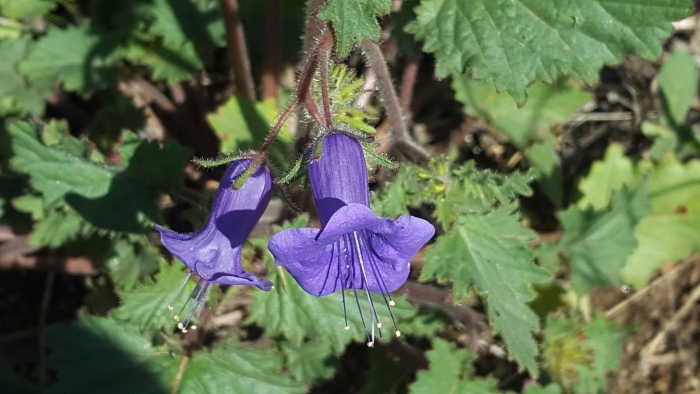Wild Canterbury Bells
(Phacelia minor)
Wild Canterbury Bells (Phacelia minor)
/
/

amthinkia
Public Domain
Image By:
amthinkia
Recorded By:
Copyright:
Public Domain
Copyright Notice:
Photo by: amthinkia | License Type: Public Domain | License URL: http://creativecommons.org/publicdomain/zero/1.0/ | Rights Holder: amthinkia | Publisher: iNaturalist | Date Created: 2021-03-04T11:28:53-08:00 |




















































Estimated Native Range
Summary
Phacelia minor, commonly known as Wild Canterbury Bells, is an annual herb native to the chaparral and coastal sage scrub ecosystems of California and the Northwestern region of Mexico. It typically grows to a height of 20 to 60 centimeters with a mostly unbranched erect stem that is glandular and coated in stiff hairs. The leaves of Phacelia minor are up to 11 centimeters long, with toothed, crinkly, oval or rounded blades borne on long petioles. The plant is notable for its showy inflorescence, a one-sided curving or coiling cyme of many bell-shaped flowers, each up to 4 centimeters in length. The large flowers are lavender to deep blue-purple in color with protruding stamens tipped with white anthers, blooming in late winter to spring.
Wild Canterbury Bells are valued for their vibrant and showy flowers, which add a splash of color to garden settings. They are often used in wildflower gardens, borders, and as a part of pollinator-friendly plantings due to their attractiveness to bees and other pollinators. This plant is adapted to dry conditions and thrives with minimal water once established, making it suitable for xeriscaping and drought-tolerant gardens. It prefers full sun exposure and well-drained soils, whether sandy or loamy. While generally low-maintenance, it can be susceptible to powdery mildew and should be spaced adequately to ensure good air circulation.CC BY-SA 4.0
Wild Canterbury Bells are valued for their vibrant and showy flowers, which add a splash of color to garden settings. They are often used in wildflower gardens, borders, and as a part of pollinator-friendly plantings due to their attractiveness to bees and other pollinators. This plant is adapted to dry conditions and thrives with minimal water once established, making it suitable for xeriscaping and drought-tolerant gardens. It prefers full sun exposure and well-drained soils, whether sandy or loamy. While generally low-maintenance, it can be susceptible to powdery mildew and should be spaced adequately to ensure good air circulation.CC BY-SA 4.0
Plant Description
- Plant Type: Herb
- Height: 1-2 feet
- Width: 0.7-1 feet
- Growth Rate: Rapid
- Flower Color: Blue, Purple
- Flowering Season: Spring
- Leaf Retention:
Growth Requirements
- Sun: Full Sun
- Water: Low
- Drainage: Medium, Fast
Common Uses
Bee Garden, Bird Garden, Butterfly Garden, Low Maintenance, Showy Flowers
Natural Habitat
Chaparral and coastal sage scrub ecosystems in California and the Northwestern region of Mexico
Other Names
Common Names: Whitlavia, Trattfacelia
Scientific Names: , Phacelia minor, Phacelia whitlavia, Whitlavia grandiflora, Phacelia whitlavia f. gracillima, Phacelia whitlavia f. heterostyla, Phacelia minor var. whitlavia, Phacelia minor subsp. whitlavia, Phacelia whitlavia f. genuina, Phacelia whitlavia f. minor
GBIF Accepted Name: Phacelia minor (Harv.) Thell.